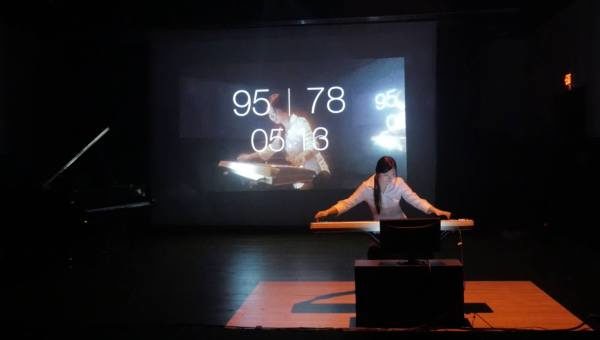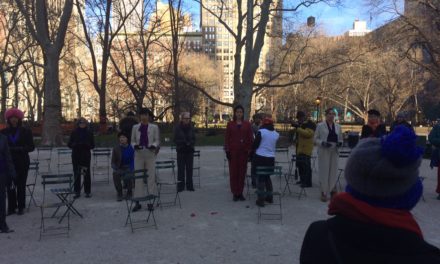Kelsey Blair reviews Hong Kong Exile’s Foxconn Frequency (no. 3): For Three Visibly Chinese Performers at the PuSh International Performing Arts Festival. The laboring body, the radicalized body, and the fluctuating boundary between the visible and invisible body, are all on display in the trio’s piano-electronica symphony:
Wearing black pants and white collared shirts, three visibly Chinese performers enter in a line. Each performer sits at an electric keyboard; like a hospital patient in an intensive care unit, the keyboard is hooked up to several contraptions: a computer screen, speakers, a 3D printer. Behind the performers, images–Chinese characters; English words; a live graph; the color red–begin to flash on the large white projection screen.
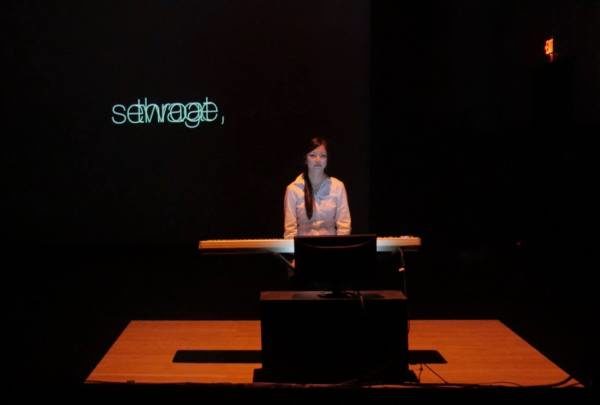
Foxconn Frequency (no. 3): For Three Visibly Chinese Performers. Photo by Vicky Shin.
Stares fixed on the computers, the performers extend their arms; the pads of their fingers touch the keys, but piano sounds don’t play over the speakers. Instead, pounding industrial music fills the theatre.
This is the opening scene of Foxconn Frequency (no 3): For Three Visibly Chinese Performers, produced by Vancouver-based company Hong Kong Exile and premiering at the 2018 Vancouver International PuSh Performing Arts Festival. Though performers Natalie Tin Yin Gan, Andrei Chi Lok Koo, and internationally acclaimed pianist Vicky Chow never speak, the premise quickly becomes clear: the trio play complex piano drills while the computers evaluate their execution. Like a video game, the performers play with and against one another, and loud sound cues alongside crisply outlined, square, spotlights help the audience track their successes and failures. The premise may seem straightforward, but Foxconn Frequency (no 3) is anything but, and the production’s complexity is both a weakness and a strength.
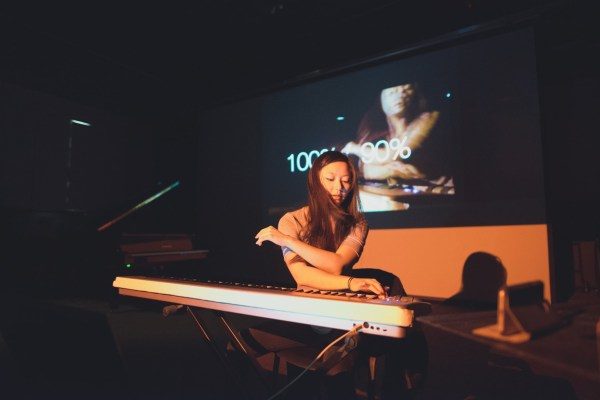
Foxconn Frequency (no. 3): For Three Visibly Chinese Performers. Photo by Vicky Shin.
For those familiar with Hong Kong Exile and project lead Remy Siu’s work, Foxconn Frequency (no 3) builds from the two previous iterations of the piece–Foxconn Frequency (no.1) (2014) and Foxconn Frequency (no 2) (2016)–to explore the relationship between sound and labor, performing bodies, and piano pedagogy. The performers tirelessly play the drills, and their movements are obviously virtuosic, but the audience never gets to hear the results of their work. At a point, this produces frustration. I’ve come to see Vicky Chow, one of Canada’s virtuosic piano talents, but I’m never going to hear her play? That seems ridiculous. The frustration, of course, is the point, and the production deftly corrals the feelings it produces to prompt the audience to think about laboring bodies, mechanization, and production.
The laboring body is particularly important for the performance’s over-arching political commentary. The production’s title draws its name from multinational electronics company Foxconn Technology Group, based in Taiwan and with multiple factories in the Republic of China. One of the world’s largest contract manufacturers, the company has been investigated for poor working conditions and is known for a series of suicides that took place in the early 2010s.
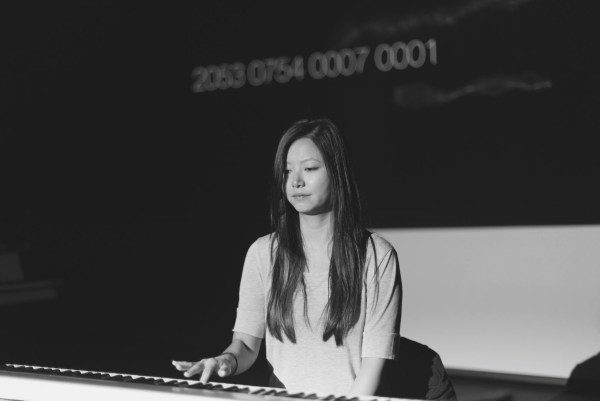
Foxconn Frequency (no. 3): For Three Visibly Chinese Performers. Photo by Vicky Shin.
This is one of the reasons why the Foxconn’s emphasis on visibly Chinese performers is essential: the piece is tethered to the bodies, living and dead, of Chinese workers. In this light, the repetitive, almost obsessive, piano exercises take on a darker inflection. This is supported by the projection of excerpts of poems by Xu Lizhi, a Foxconn factory worker who died by suicide in 2014.
Near the end of the performance, Chi Lok Koo leaves the stage. His exit is clearly meant to gesture to the death of factory workers. Alongside Xu Lizhi’s words, the moment veers on poignant, but the piece’s multiple layers–the pounding sounds, the strobing projections; the video feeds; the unclear purpose of the 3D printers–don’t quite coalesce, limiting the emotional and political resonance of his exit. That said, the piece’s final image–two visibly Chinese female performers onstage pounding piano keys that make no sound–is powerful, and the production’s impressive technology, in combination with its complex intellectual underpinnings, make for thought-provoking avant-garde theatre.
This article originally appeared in Alt Theatre on April 24, 2018, and has been reposted with permission.
This post was written by the author in their personal capacity.The opinions expressed in this article are the author’s own and do not reflect the view of The Theatre Times, their staff or collaborators.
This post was written by Hayley Malouin.
The views expressed here belong to the author and do not necessarily reflect our views and opinions.

